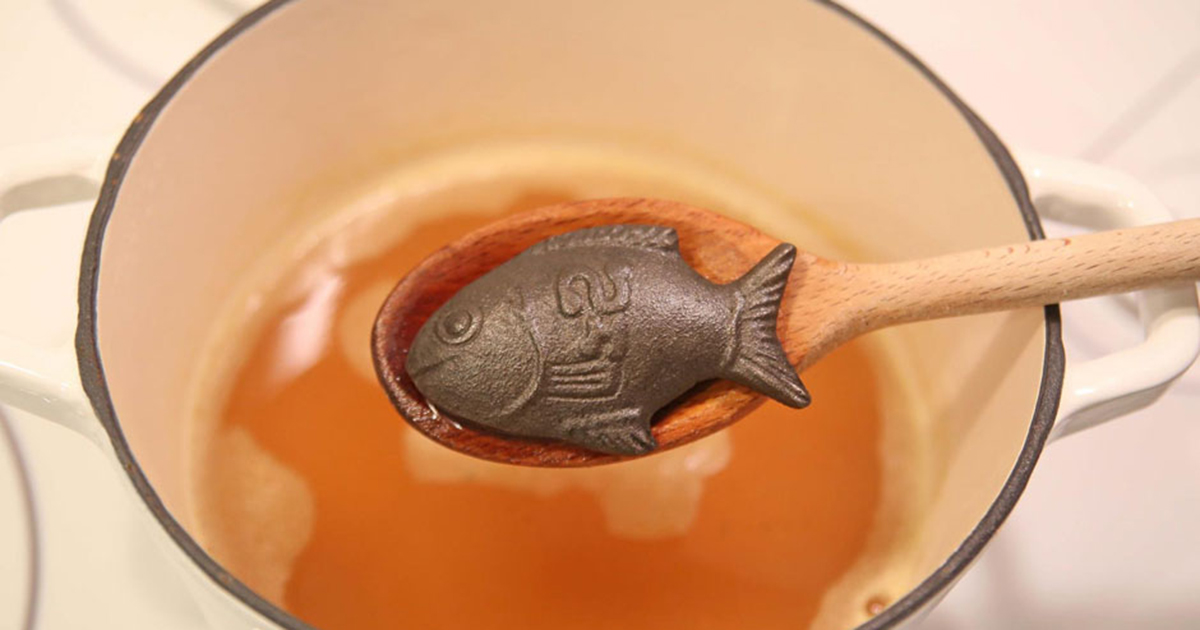Fighting Global Iron Deficiency, One Lucky Iron Fish at a Time

Sets of three are lucky in Cambodia.
When Dr. Gavin Armstrong incorporated his company Lucky Iron Fish on 12/12/12, he wasn’t thinking much about luck. Then, just 25 years old, he had been working in Cambodia where more than 50 percent of the population suffers from iron deficiency. “In Cambodia, there’s actually no word for iron deficiency, so people call it yellow skin syndrome,” says Armstrong. “Women and children especially get very tired and dizzy, have bad headaches, and are much more susceptible to other diseases like malaria or HIV.”
Conventional treatment involves taking oral iron supplements, distributed predominantly by NGOs and aid groups. According to Armstrong, spending on iron supplements has gone up between 20 and 30 percent since 2000, but the iron deficiency rates keep climbing. “We’re spending billions of dollars more per year to solve a problem that’s only getting worse,” he says.
Simplifying the Solution
 Instead of engineering a complex solution, Armstrong found opportunity in simplicity. Working with Cambodian designers, he developed a 3-inch-long cast iron fish that can be dropped into a soup or stew pot during cooking. As the food cooks, the Lucky Iron Fish™ releases up to 90 percent of one’s required daily iron intake. One fish can benefit an entire family, and is reusable for up to five years. The fish also is designed to tell you when it’s ready to be replaced—the smile etched onto the fish’s face slowly fades with daily use, indicating when it’s time for a new Lucky Iron Fish.
Instead of engineering a complex solution, Armstrong found opportunity in simplicity. Working with Cambodian designers, he developed a 3-inch-long cast iron fish that can be dropped into a soup or stew pot during cooking. As the food cooks, the Lucky Iron Fish™ releases up to 90 percent of one’s required daily iron intake. One fish can benefit an entire family, and is reusable for up to five years. The fish also is designed to tell you when it’s ready to be replaced—the smile etched onto the fish’s face slowly fades with daily use, indicating when it’s time for a new Lucky Iron Fish.
“The technology we use has been around since 500 B.C.,” says Armstrong. “Even though iron deficiency is a complex issue, the Lucky Iron Fish isn’t a complex solution.” He adds that overcoming perception that his company is too simple has been one of its biggest challenges for the growing his business. “Lots of people don’t believe us because they say it’s too easy, so we try to educate people that sometimes simplicity is the best answer.”
The results speak for themselves, and encourage Armstrong and his team that this is a solution that can scale. More than 80,000 fish have been sold or distributed internationally, primarily in southeast Asia. After just nine months of using the Lucky Iron Fish every day, Armstrong and his team saw a 50 percent decrease in the incidence of clinical iron deficiency among Cambodian families. Even more gratifying, says Armstrong, is the compliance rate. “Iron supplements in Cambodia have a compliance rate of around 32 percent because they come with terrible side effects,” he says, “but there’s a 92 percent compliance rate with the Lucky Iron Fish, and people can really feel the difference.”
Embracing Social Enterprise
Armstrong didn’t set out to take on a major global health challenge. In fact, he entered his college years set on a career in banking. A variety of experiences contributed to the change in course, including volunteer work for the World Food Program at Dadaab, a refugee camp that’s home to hundreds of thousands of refugees in northern Kenya.
“WFP does an amazing job, but what really frustrated me while working in this camp was the overall Band-Aid approach to aid,” says Armstrong. “People would wait for hours in food lines every day, just to wake up the next day and do it all over again. This helped me realize that philanthropy wasn’t for me—it was just too frustrating. I came back to my business roots and am a strong believer that businesses have the tools and resources to solve some of the world’s most daunting challenges.”
New Business Models for Global Health
While elegant in its simplicity, Lucky Iron Fish is a departure from global healthcare business as usual. “There is growing concern that our eyes have been on healthcare ‘fires‘ like Zika or HIV/AIDS, while procedures that individuals in developed countries take for granted have been slowly smoldering with significantly less attention,” says Wiljeana Jackson Glover, an assistant professor at Babson College.
For example, a woman in labor in a rural Indian town cannot be ensured a safe delivery because surgical care and anesthesia may not be available. A man suffering from a heart attack in Zambia cannot be guaranteed that he will arrive to the hospital in time because inadequate transportation and infrastructure may keep him away from a life-saving stent. These are challenges that, like widespread iron deficiency, can benefit from business model innovation and redesign.
To that end, Babson is home to the Schlesinger Fund for Global Healthcare Entrepreneurship, bringing together entrepreneurs, engineers, and doctors in an effort to improve and address global health challenges. The initiative hosts hackathons and has produced case studies inspired by the same action-oriented spirit as Lucky Iron Fish.
Aid agencies can only do so much, and working in partnership with NGOs on the ground the way the Schlesinger Fund and Lucky Iron Fish do can free up life-saving funds. As Armstrong illustrates, “Five years of iron supplements for every Cambodian child in need would cost around $500 million, while five years of using the lucky iron fish costs only $2 million. That’s $498 million to devote to other problems.”
Posted in Entrepreneurial Leadership





